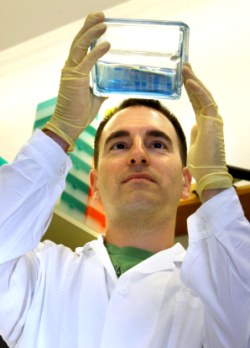Matan Rapoport, a research student in the Department of Cell Biochemistry and Human Genetics at the Faculty of Medicine of the Hebrew University, developed an approach to treating metabolic disorders through guided enzyme replacement

A young researcher has developed an innovative approach to the treatment of metabolic disorders using guided enzyme replacement (DERT).
Directed Enzyme Replacement Therapy is a therapeutic approach to metabolic disorders that originate from damage to the activity of an enzyme. According to this approach, the enzyme is artificially produced with the addition of a transport component and given to patients on a regular basis.
In every cell in our body there are small special structures (mitochondria). These structures play an essential role: most of the biochemical processes take place in them, and their main role is to generate energy for the cells and get rid of toxic waste that is created in the metabolic process.
Thousands of enzymes related to the metabolic activity of the cell work inside the mitochondria. If one of the enzymes is damaged due to a genetic change, a disturbance to the metabolism is caused. Modern medicine has not found a cure for this type of genetic disorders (including myopathies that damage the muscle, maple syrup disease and many others). The treatment offered today is only intended to relieve the patient, and fails to prevent the massive damage caused by the overproduction of free radicals, the accumulation of toxic waste and the low rate of energy production.
Matan Rapoport, a research student in the Department of Cell Biochemistry and Human Genetics at the Faculty of Medicine of the Hebrew University, proved the effectiveness of the approach in the treatment of a metabolic disorder resulting from damage to the enzyme LAD (lipoamide dehydrogenase deficiency). It is a recessive hereditary disorder (that is, only if both parents carry the defective gene, the disease is passed on to the offspring) which manifests itself in widespread disturbances in metabolism due to a decrease in the activity level of the enzyme inside the mitochondria.
The clinical manifestation of the LAD deficiency disease differs from patient to patient - when the disease appears in infancy, it manifests as a neurological disease of varying degrees of severity, and if it appears later in life, it usually manifests as severe liver failure attacks.
Rapoport proposed a novel but simple approach to transport the artificial LAD enzyme directly to its location in the cell. With the help of a unique transport component attached to it, the artificial enzyme reaches the cell and into the mitochondria, replaces the defective enzyme and functions in its place.
In the last four years, Rapoport - under the guidance of Professor Haya Lorberbaum-Galsky from the Hebrew University - conducted experiments under laboratory conditions with cells taken from patients suffering from enzyme deficiency. The experiments yielded positive results. Preliminary experiments done recently in mice suffering from the disease showed promising results and proved the ability of the treatment to improve the activity of the LAD enzyme even in the mouse brain.
Rapoport says that the treatment for guided replacement of the enzyme looks very promising and is a technological basis for the development of similar treatments and their application in many other genetic diseases. Matan Rappaport's invention was registered as a patent by the Hebrew University of Jerusalem Research Development Company.
For the development, Matan Rapoport received the prestigious Kay Award at a ceremony held as part of the 71st session of the Board of Trustees of the Hebrew University.

3 תגובות
Ariel,
Unfortunately, I do not have access to the article through the Technion. If you have access to the journal Molecular Therapy through a university, you can find the full article at
http://www.nature.com/mt/journal/vaop/ncurrent/full/6300410a.html
Good Day,
Roy.
You can get more details about the "unique transport component attached to it".
1. What exactly is it? Any protein? Fatty micelles?
2. How does the supplied enzyme pass through the cell membrane and also through the mitochondrial membranes?
Thanks.
Well done